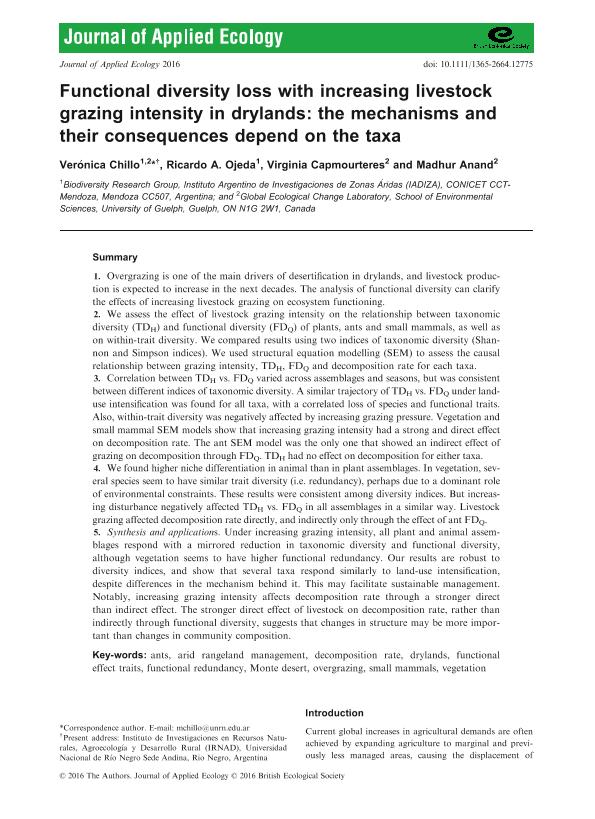Mostrar el registro sencillo del ítem
dc.contributor.author
Chillo, María Verónica

dc.contributor.author
Ojeda, Ricardo Alberto

dc.contributor.author
Capmourteres, Virginia
dc.contributor.author
Anand, Madhur
dc.date.available
2019-06-05T21:47:01Z
dc.date.issued
2017-06-17
dc.identifier.citation
Chillo, María Verónica; Ojeda, Ricardo Alberto; Capmourteres, Virginia; Anand, Madhur; Functional diversity loss with increasing livestock grazing intensity in drylands: the mechanisms and their consequences depend on the taxa; Wiley Blackwell Publishing, Inc; Journal of Applied Ecology; 54; 3; 17-6-2017; 986-996
dc.identifier.issn
0021-8901
dc.identifier.uri
http://hdl.handle.net/11336/77704
dc.description.abstract
Overgrazing is one of the main drivers of desertification in drylands, and livestock production is expected to increase in the next decades. The analysis of functional diversity can clarify the effects of increasing livestock grazing on ecosystem functioning. We assess the effect of livestock grazing intensity on the relationship between taxonomic diversity (TDH) and functional diversity (FDQ) of plants, ants and small mammals, as well as on within-trait diversity. We compared results using two indices of taxonomic diversity (Shannon and Simpson indices). We used structural equation modelling (SEM) to assess the causal relationship between grazing intensity, TDH, FDQ and decomposition rate for each taxa. Correlation between TDH vs. FDQ varied across assemblages and seasons, but was consistent between different indices of taxonomic diversity. A similar trajectory of TDH vs. FDQ under land-use intensification was found for all taxa, with a correlated loss of species and functional traits. Also, within-trait diversity was negatively affected by increasing grazing pressure. Vegetation and small mammal SEM models show that increasing grazing intensity had a strong and direct effect on decomposition rate. The ant SEM model was the only one that showed an indirect effect of grazing on decomposition through FDQ. TDH had no effect on decomposition for either taxa. We found higher niche differentiation in animal than in plant assemblages. In vegetation, several species seem to have similar trait diversity (i.e. redundancy), perhaps due to a dominant role of environmental constraints. These results were consistent among diversity indices. But increasing disturbance negatively affected TDH vs. FDQ in all assemblages in a similar way. Livestock grazing affected decomposition rate directly, and indirectly only through the effect of ant FDQ. Synthesis and applications. Under increasing grazing intensity, all plant and animal assemblages respond with a mirrored reduction in taxonomic diversity and functional diversity, although vegetation seems to have higher functional redundancy. Our results are robust to diversity indices, and show that several taxa respond similarly to land-use intensification, despite differences in the mechanism behind it. This may facilitate sustainable management. Notably, increasing grazing intensity affects decomposition rate through a stronger direct than indirect effect. The stronger direct effect of livestock on decomposition rate, rather than indirectly through functional diversity, suggests that changes in structure may be more important than changes in community composition.
dc.format
application/pdf
dc.language.iso
eng
dc.publisher
Wiley Blackwell Publishing, Inc

dc.rights
info:eu-repo/semantics/openAccess
dc.rights.uri
https://creativecommons.org/licenses/by-nc-sa/2.5/ar/
dc.subject
Ants
dc.subject
Arid Rangeland Management
dc.subject
Decomposition Rate
dc.subject
Drylands
dc.subject
Functional Effect Traits
dc.subject
Functional Redundancy
dc.subject
Monte Desert
dc.subject
Overgrazing
dc.subject
Small Mammals
dc.subject
Vegetation
dc.subject.classification
Otras Ciencias Biológicas

dc.subject.classification
Ciencias Biológicas

dc.subject.classification
CIENCIAS NATURALES Y EXACTAS

dc.title
Functional diversity loss with increasing livestock grazing intensity in drylands: the mechanisms and their consequences depend on the taxa
dc.type
info:eu-repo/semantics/article
dc.type
info:ar-repo/semantics/artículo
dc.type
info:eu-repo/semantics/publishedVersion
dc.date.updated
2019-05-23T19:12:34Z
dc.journal.volume
54
dc.journal.number
3
dc.journal.pagination
986-996
dc.journal.pais
Reino Unido

dc.journal.ciudad
Londres
dc.description.fil
Fil: Chillo, María Verónica. Consejo Nacional de Investigaciones Científicas y Técnicas. Centro Científico Tecnológico Conicet - Mendoza. Instituto Argentino de Investigaciones de las Zonas Áridas. Provincia de Mendoza. Instituto Argentino de Investigaciones de las Zonas Áridas. Universidad Nacional de Cuyo. Instituto Argentino de Investigaciones de las Zonas Áridas; Argentina. University of Guelph; Canadá
dc.description.fil
Fil: Ojeda, Ricardo Alberto. Consejo Nacional de Investigaciones Científicas y Técnicas. Centro Científico Tecnológico Conicet - Mendoza. Instituto Argentino de Investigaciones de las Zonas Áridas. Provincia de Mendoza. Instituto Argentino de Investigaciones de las Zonas Áridas. Universidad Nacional de Cuyo. Instituto Argentino de Investigaciones de las Zonas Áridas; Argentina
dc.description.fil
Fil: Capmourteres, Virginia. University of Guelph; Canadá
dc.description.fil
Fil: Anand, Madhur. University of Guelph; Canadá
dc.journal.title
Journal of Applied Ecology

dc.relation.alternativeid
info:eu-repo/semantics/altIdentifier/doi/https://doi.org/10.1111/1365-2664.12775
dc.relation.alternativeid
info:eu-repo/semantics/altIdentifier/url/https://besjournals.onlinelibrary.wiley.com/doi/full/10.1111/1365-2664.12775
Archivos asociados
